Veteran’s Testimony – Richard “Doc” FELIX Medical Detachment, D Company, 5th Ranger Infantry Battalion

Corporal Richard “Doc” Felix (ASN: 32983385) photographed relaxing somewhere overseas.
Introduction:
I was born in NYC in 1925. Before entering the US Army in July 1943, I attended the College of the City of New York, where I majored in Advertising and Marketing (I completed my BBA and MBA after returning from the ETO in September 1945, with the aid of the G.I. Bill). My postwar business career has always been in the areas of marketing and advertising.
Training:
I was a 19-year old student when I joined the Army after 3 years of College. I enlisted on 13 July 1943 as a Draftee. My Army Serial Number was 32983385.
I took 6 months of Basic Training as well as Medical Training, learning to become a ‘Doc’, i.e. stop bleeding – prevent shock and infection – use airtight bandages for chest wounds – ‘splint ‘em where they lie” – apply drugs and sulfanilamide – administer morphine – etc. My real Medical Training started at Camp Grant (MRTC, representing an acreage of 3,349, with a troop capacity for 453 Officers and 20,836 Enlisted Men), one of the largest centers in the United States for training Medical personnel. It was located in Rockford, Illinois, 90 miles from Chicago. I was based there from July to December 1943.
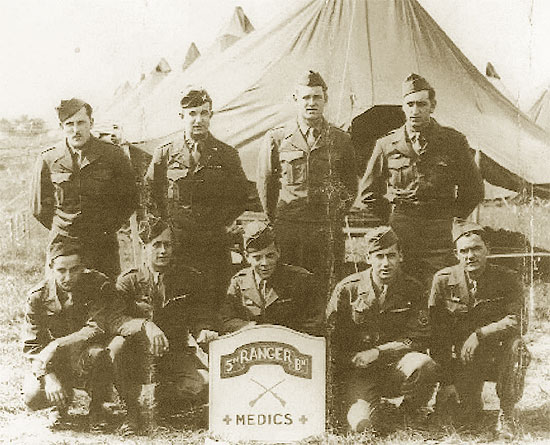
Partial view showing some of the ‘Medics’ pertaining to the 5th Ranger Infantry Battalion (unfortunately we don’t know where and when the picture was taken).
Standing, left to right: Pfc Roger F. DeTore; Capt. Joe H. Hilsman, Jr.; Pfc Winfield F. Hanny; T/5 Raymond G. Knajdek.
Kneeling, left to right: Pfc Joseph T. Lowe; Pfc Jessie W. Johnson; Pfc Harold L. Hasselback; T/3 Alexander W. Barber; S/Sgt William G. Taylor.
Missing from this photograph: T/4 Earl E. Bishop; T/5 Jack Pecker and Cpl Richard Felix
About half my time spent at Cp. Grant was devoted to learning the basic skills of a “combat” medic! Learning about the human body and the damage that could be inflicted by a wound, and the repair job that went with it. Reducing pain and suffering was another important item because it played an important role in protecting the patient against shock and boosted his morale as well as that of his comrades. To achieve this, basic household remedies for pain sometimes helped, but it was morphine injections, using the ‘syrette’ together with sleeping pills (referred to as “Blue 88s”, I’m not sure about their exact name, probably Sodium Amytal – utilized for amobarbital, which is a barbiturate used as a hypnotic and sedative) that did the best job. Morphine helped, it was very effective as a pain-killer but it also had some limitations. It couldn’t be used for stomach wounds because it accelerated bleeding. It was also addictive, and I always had to protect my supply of syrettes, wherever I went …

Stateside Training of Ranger recruits. Picture taken in 1943, probably somewhere in the area of Cp. Forrest, Tullahoma, Tennessee, ZI.
We had several professional people with us, who had worked as orderlies at civilian Hospitals before the war. Their practical training and medical experience provided us with extra know-how.
The rest of my Basic Training (13 weeks) was devoted to being an Infantryman and included following subjects included in the ‘Master’ Program:
Military Courtesy and Discipline
Personal Hygiene, Sanitation and First Aid
Equipment, Clothing and Tent Pitching
Individual Defense Against Chemical Attack
Individual Defense Against Air, Parachute, and Mechanized Attack
Interior Guard Duty
Dismounted Drill
Marches and Bivouacs
Physical Training
Hasty Entrenchments and Shelter
Elementary Anatomy and Physiology
Nomenclature and Care of Organization Equipment
Field Medical Records
Treatment of Gas Casualties
Litter Drill
Field Sanitation and Sanitary Appliances
Materia Medica and Pharmacy
Medical and Surgical Nursing
Heavy Tent Pitching
Organization and Function of the Arms
Organization and Function of the Medical Unit
Medical Aid, including Splints and Splinting, Bandages and Dressings
Movement by Motor
Movement by Rail
Scouting and Patrolling
Map and Aerial Photograph Reading
Orientation in Night Combat
Communication in Combat
Technical and Tactical Employment of Medical Field Units
Troop Movements by Motors
Inspections
The physical aspect of above Training often included speed marches, and 15-mile hikes with full medical load (60 to 80 lb of equipment).
Overseas Movement:
On New-Year’s day of 1944, I left the New York Port of Embarkation as a ‘potential’ Replacement. Our ship, part of a large convoy that zigzagged across the Atlantic, arrived in Liverpool, United Kingdom, after 11 days at sea. After disembarking, I took a train to Medical Department Headquarters, Cheltenham, Gloucestershire, where I received an office job. There was no further Training. We lived in stables near the famous racetrack (one of the finest in the whole of England located on the northern outskirts in Prestbury) for about one month. Cold and damp weather caused a mild influenza epidemic and we were therefore now billeted in private homes. This was quite an improvement and also provided more social contact with the local population. During this short period, I served as a Statistician (because of my College degree).

Photograph showing members of the 5th Ranger Battalion standing in front of Battalion Headquarters at Markt Grafing in August 1945.
Standing (L to R): S/Sgt Warren “Red” Adams, S/Sgt M. V. Doyle.
Kneeling (L to R): Pfc Harry Guthartz; Sgt “Abe” Abraham.
France:
When MAC Headquarters moved to Paris next October 1944, I volunteered for combat and requested a transfer to a combat unit. I was subsequently sent to a Replacement Depot in France (located about 50 miles from St. Avold, itself being 18 miles east of Metz) where I was destined to hook up with the 5th Ranger Battalion.
During the months of October-November 1944, the 5th Ranger Battalion acted as a Headquarters security force for Lt. General Omar N. Bradley’s Twelfth Army Group at Differt, Belgium (staying at the Marist Brothers Seminary). The Battalion left Belgium on 7 November, returning to France, where it was stationed at Toul and Nancy. Early December, it linked up with the 6th Cavalry Group (Third US Army), conducting small-scale operations in the vicinity of St. Avold, France.
When the 5th Rangers were seeking replacements to fill in their depleted ranks after combat in France, they recruited about a dozen infantrymen and a medic that was me! I was assigned as a Private First Class (promoted to Corporal in March 1945) to D Company (CO > Captain George Miller) and immediately sent to St. Avold, France, where we trained for a few weeks (approximately 1 month) and celebrated Christmas in Metz before being rushed to the frontline on 30 December 1944, right into the Bulge fighting, in order to help strengthen the right flank!
However, we never got into action because the Germans did not attack our positions and were repulsed by a combination of infantry, armor and air power that inflicted many casualties onto the enemy. The weather cleared and this got the Allies back on the offensive! Once the Bulge was cleaned up, we started aggressive patrolling and between 15 January and 5 February 1945, we extensively patrolled an area of the Siegfried Line near Wehingen, Germany and reconnoitered the region. On 9 February, the 5th Ranger Infantry Battalion (CO > Lt. Colonel Richard P. Sullivan) was attached to the 94th Infantry Division, taking over a large section of their sector.
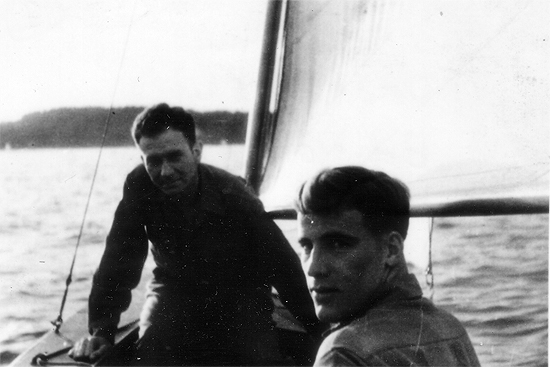
Doc Felix (left) and S/Sgt Robert Morgan (right) pictured whilst on R&R. Chiemsee, Bavaria. Photograph taken June 1945.
The 5th Ranger Infantry Battalion was activated at Cp. Forrest, Tennessee on 1 September 1943. It started with a cadre of 34 Officers and 563 Enlisted personnel. Under command of Lt. Colonel Owen H. Carter (CO) and Captain Richard P. Sullivan (XO), the Battalion began extensive training including speed marches, tactical exercises and weapons firing throughout 14 September to 3 November. Amphibious Training then followed at Ft. Pierce, Florida, on 5 November. After transfer to Ft. Dix, New Jersey, where they arrived on 20 November 1943, the men started final preparations for the big move overseas. After moving to Cp. Kilmer, New Jersey on 20 December, the unit, after due preparations and more training, embarked on the ocean liner “Mauretania” and sailed from New York POE on 9 January 1944, carrying among its troop contingent, the entire 5th Ranger Battalion. Nine days later, the ship docked at Liverpool, and the Rangers moved by train to Leominster, England, where more vigorous training began almost immediately…
Germany:
The Third United States Army (to which we were still attached) gave us the opportunity to launch a behind-the-lines mission across the Saar River bridgehead, a kind of operation ideally suited for a Ranger unit. Our Battalion was to infiltrate through the lines defended by the 94th Infantry Division to cut off and hold the Irsch-Zerf road, and seize high ground overlooking the supply route between Irsch and Zerf (a German railroad center), in order to deny the German 2d Mountain Division from receiving supplies and reinforcements, and to clear the way for a breakthrough by the 94th Infantry and 10th Armored Divisions. The sector was heavily defended by concrete pillboxes, dragon teeth, barbed wire, and mines. The mission started at 2345 hours, 23 February and lasted until 4 March. It proved successful and achieved all its objectives.
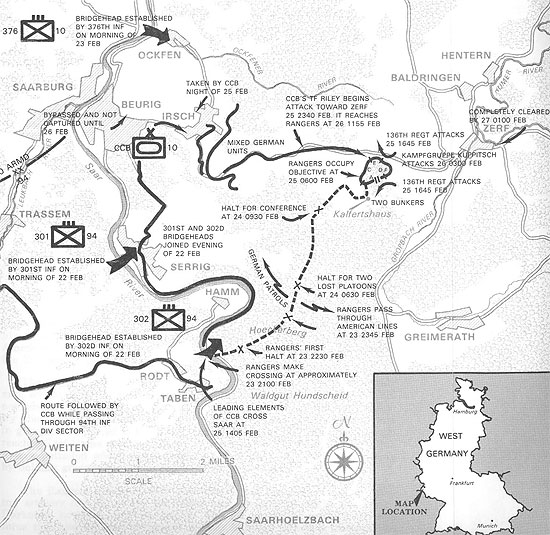
Partial Map illustrating the Irsch-Zerf Operation, February 1945 (courtesy US Army Command & General Staff College, Ft. Leavenworth, Kansas, 1985).
The “mission” involving the 5th Rangers was composed of following Companies advancing in 2 columns; a left column comprising C – F – A Companies, and a right column formed of D – E – B Companies. This represented a force of 20 Officers and 378 Enlisted personnel. A Liaison Team of the 284th Field Artillery Battalion under command of Captain Stephen McPortland accompanied the group.
From the training I received, I learned how to interact with my fellow-soldiers and to provide the medical support needed once the action started. Our casualties were very high. When we completed operations, there were only about 160 Rangers still standing out of the approximately 500 who took part in this mission. We saved a great percentage of the wounded despite the fact that we couldn’t evacuate any of them during the initial 4-5 days when we were cut off behind enemy lines. We further suffered about 90 KIAs. According to after action reports, while supporting artillery (284th Field Artillery Battalion, 105mm Howitzers) killed an estimated 378 Germans, wounded 550, and captured another 562. The operation was a success, though a costly one. 38 percent of the men KIA in the entire war period were killed in the 9 days of severe fighting during the mission at Irsch-Zerf (45 killed, 140 wounded, and 12 missing or captured).
| Late War Assignments | |
|---|---|
| 1 December 1944 | Sixth Cavalry Group |
| 28 December 1944 | 95th Infantry Division |
| 9 February 1945 | 94th Infantry Division |
| 21 February 1945 | Third Cavalry Group |
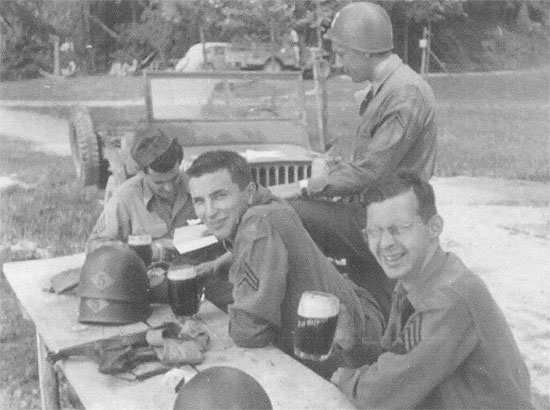
Some 5th Ranger Infantry Battalion personnel in Germany, during spring of 1945. They are members of one of the road patrols operating on behalf of Military Government authorities (helmet liners are still adorned with the 5th Ranger Diamond, while a corresponding SSI is visible on the Corporal’s left shirt sleeve).
It was reported that A Company (CO > Captain Charles A. Parker) captured a German doctor accompanied by 4 aidmen. He couldn’t believe there were American troops behind German lines. Despite his surprise and his PW status, he proved of good service in caring for both German and American wounded during the mission.
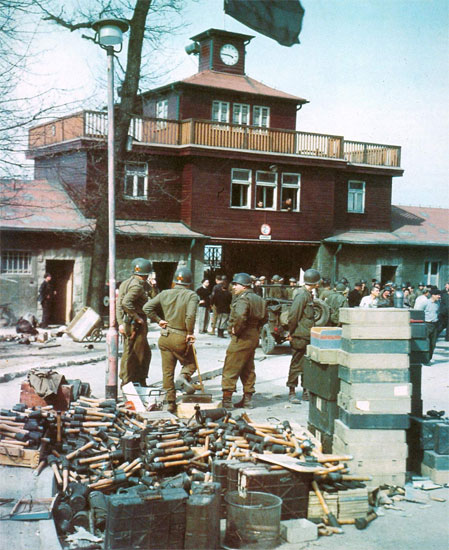
Buchenwald Concentration Camp: 5th Ranger personnel stand outside the newly liberated camp. In front are a number of various ammunition boxes and cases (see numerous Model 1924 Stielhandgranate) collected from the guard warehouse. This picture most probably dates from 16 April 1945 (see Testimony).
Luxembourg:
The following period (starting 6 March) was spent in the Grand Duchy of Luxembourg (Schwebsingen), where the unit licked its wounds, and received the necessary replacements (191 men) to replace losses suffered during the previous operation. Passes were obtained to visit the cities of Luxembourg and Arlon, Belgium. On March 19, we moved to Trier, Germany. D Company now guarded a Camp for DPs. Most of the time the Battalion was occupied with police tasks, trying to maintain law and order in captured towns and villages, and searching for remaining German soldiers, guarding warehouses and supply dumps. On 16 April, our Battalion was tasked to escort German civilians to visit KZ-Buchenwald. On 21 April 1945, we were attached once more to another organization, the 3d Cavalry Group, for the last drive toward Austria, and securing bridges over the Danube River. D Company (with A + F Company) was now attached to the 43d Cavalry Squadron.
Austria:
The war was now coming to a close. On 7 May 1945, the 5th Rangers moved to various assigned areas in Austria. Our Battalion spent the remainder of the month guarding PW enclosures and in garrison duties. Losses amounted to 116 KIA, 552 WIA, and 27 MIA or captured. Campaigns in which we participated were: Normandy, Northern France, Rhineland, Ardennes-Alsace, and Central Europe, I having served as a Ranger in the latter three.
BSM Award:

Official Award ceremony. Corporal Richard “Doc” Felix is being decorated in the presence of his comrades (note the Geneva Convention Brassard). Cpl. Felix is being awarded the Bronze Star medal as per G. O. 145. This must be a late war picture, as the majority of the men wear M-1944 Field Jackets.
G. O. 145 (dated 25 August 1945) read as follows:
Corporal (then Private First Class) Richard Felix, 32983385, MD, 5th Ranger Infantry Battalion, for heroic achievement in connection with military operations against the enemy on 28 February 1945. When Corporal Felix’s Company was subjected to intense artillery and rocket fire and several men were wounded, he ran fearlessly through the hail of shells, lifted a casualty to his shoulder and carried him to safety. Corporal Felix’s cool courage, and devotion to the safety of others merit great praise. Entered Military Service from New York.”
Doc Felix added the following commentary on the incident:
The casualty was Pfc Presley NMI Vining, D Co., who received severe facial wounds from an artillery shell tree burst at about the same time that concussion from a series of tree bursts flattened me. When I came to, I was able to carry him out of harm’s way, slow down his bleeding and then carry him about 3/4 of a mile to the Battalion Aid Station. I received a Purple Heart (GO 3, 26 March 1945).
Pfc Vining received additional treatment at the Aid Station and was evacuated to a Hospital where the surgeons performed excellent facial surgery. He never returned to the outfit. I never saw him again, but I did hear from those who had seen him after the war that the surgery had been successful and that he looked very good. I was sent by truck to a Field Hospital where I slept overnight. When a truck came from the Battalion bringing in more wounded Rangers the next morning, I hopped on and returned to D Company in time to greet the fresh troops that replaced us on 5 March.
| World War 2 Campaign Credits | |
|---|---|
| 6 June 1944 > 24 July 1944 | Normandy |
| 25 July 1944 > 14 September 1944 | Northern France |
| 15 September 1944 > 21 March 1945 | Rhineland |
| 16 December 1944 > 25 January 1945 | Ardennes-Alsace |
| 22 March 1945 > 11 May 1945 | Central Europe |
| Unit Awards | |
| Presidential Unit Citation (Army) | Pointe-du-Hoc (WD GO 10, 1945) |
| Presidential Unit Citation (Army) | Saar River Area (WD GO 23, 1947) |
5th Ranger Medical Detachment Roster:
| Captain Joseph R. Lacy (Chaplain) | Technician 5th Grade Raymond G. Knajdek |
| Captain Thomas G. Petrich | Technician 5th Grade Jack Pecker |
| Captain Joe H. Hilsman Jr.* | Private First Class David W. Beas |
| Staff Sergeant Frank R. Bartlett Jr. | Private First Class Roger F. DeTore |
| Staff Sergeant John L. Burke | Private First Class Guy E. Fields |
| Staff Sergeant Peter V. Mullin | Private First Class Winfield F. Hanny |
| Staff Sergeant William G. Taylor | Private First Class Jessie W. Johnson |
| Technician 3d Grade Alexander W. Barber** | Private First Class Harry G. Lemperis |
| Technician 3d Grade John D. Jeanes | Private First Class Joseph T. Lowe |
| Technician 4th Grade Earl E. Bishop | Private First Class James G. McDaniel |
| Technician 4th Grade David L. Clawson | Private First Class George C. Morris, Jr. |
| Corporal John P. Amador | Private Alfred T. Cox |
| Corporal Richard Felix | Private Melvin D. Motos |
* Capt. Joe H. Hilsman, Jr. served as Battalion Surgeon from the Irsch-Zerf mission on to V-E Day.
** T/3 Alexander W. Barber was decorated with the Distinguished Service Cross for his actions on D-Day.
Return to ZI & Honorable Discharge:

Partial photo illustrating some of the Officers of the 5th Ranger Infantry Battalion taken in September 1945.
Once the war ended on V-E Day, 8 May 1944, we were transported by bus to serve in a variety of places in Germany and as far west as Linz, Austria (where Hitler lived at some time in his life). We helped to restore normal services to its citizens. We patrolled the Autobahn serving as police. In early August 1945, we began the long trip home through the “cigarette camps” in France, i.e. Lucky Strike, Old Gold etc. Each one took us closer to embarking at a French port (I believe it was Le Havre). We embarked on a small ship, the SS Sea Snipe (the crew was British) and arrived in Boston Harbor and berthed near Camp Miles Standish where the unit was deactivated on 22 October 1945. We traveled by railroad to Fort Dix, New Jersey about 90 minutes by bus from where I lived with my mother and brother in New York City. At Fort Dix, I received an Honorable Discharge dated 26 October 1945.
I had entered the Army on 13 July 1943 as a nineteen year-old boy and emerged one year, nine months and six days later, a grown man.
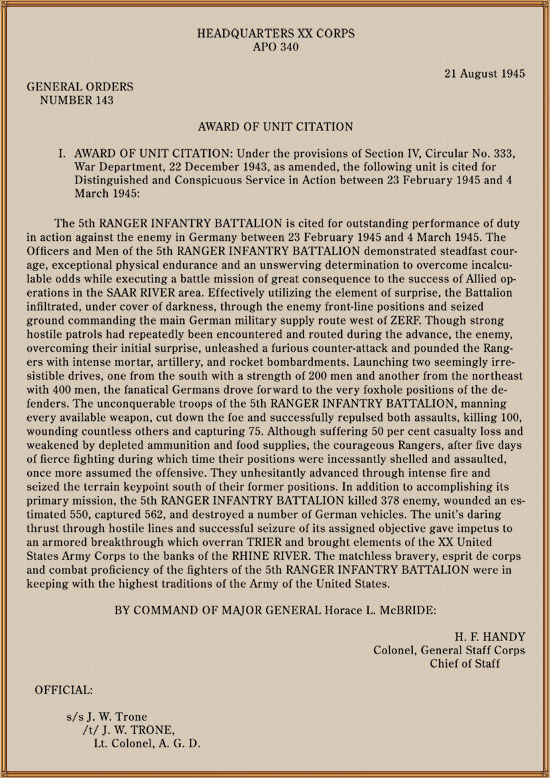
Facsimile of the Unit Citation, dated 21 August 1945, awarded to the 5th Ranger Infantry Battalion for its participation in the ZERF Operation (23 February > 4 March 1945).
We are indebted to “Doc” Felix for sharing some of his personal reminiscences with the MRC staff. Veteran Richard Felix (ASN:32983385) was a member of the Medical Detachment, attached to ”D” Company, 5th Ranger Infantry Battalion, a unit he served with during the latter part of World War 2. The authors added a number of extra data and pictures relating to the 5th Ranger Battalion. We are still looking for additional information covering the exploits of medical personnel having served with US Army Rangers during World War 2. Thank you.
